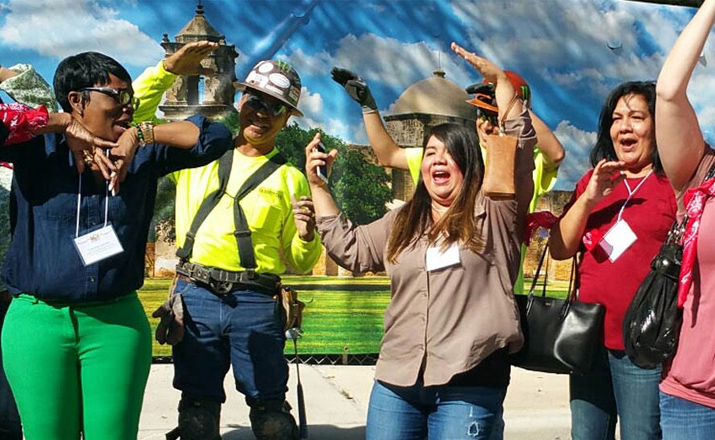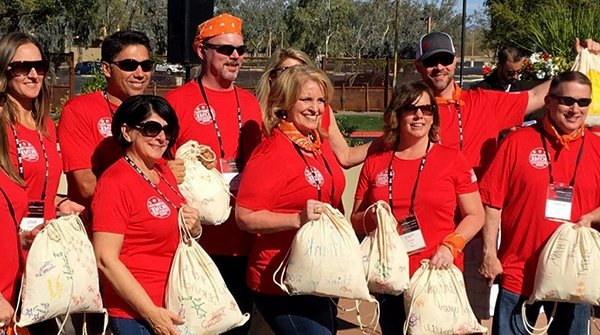How to Develop an Employee Volunteer Training Program

Volunteering has been shown to improve employee wellbeing and strengthen workplace relationships, but it’s not always easy to facilitate volunteer opportunities for your people. That’s why creating a volunteer training program for your team can help guide your decisions and get people engaged.
To improve and maintain your employees’ well-being, your business needs to provide them with meaningful work that benefits them and their community. In fact, 64% of employees who volunteered through their workplace said it strengthened their work relationships.
And providing these opportunities as a business makes becoming a volunteer even easier for employees and encourages a workplace culture of caring.
Having a volunteer program not only benefits your employees but also your overall business. It shows customers evidence that your organization puts its values into action, whether by improving your local area, standing for ethical beliefs, or supporting charity work. This, in turn, displays integrity and motivations beyond revenue and profits, making customers more comfortable supporting your brand and buying your products. Similarly, having available funding shows the support of others for your volunteering program. Even budgets from within the business demonstrate the investment in volunteer projects to improve the community and the lives of others. This can also encompass to using funding revenue model for estimating a company’s revenue, facilitating better resource allocation and sustainability planning for impactful volunteer initiatives.
So, how can you effectively implement a volunteer program within your organization? Read on to find out.
- What Is an Employee Volunteer Training Program?
- How to Develop Your Volunteer Training Program
- Assess the Needs of Your Community
- Identify Your Purpose
- Get the Funding
- Plan and Carry Out Your Projects
- Make It Bigger and Better
- Tips for Engaging Your Employees in Your Volunteer Program
- What Does Your Volunteer Training Program Look Like?
What Is an Employee Volunteer Training Program?

Training and preparation are often needed to upskill your workforce when they’re preparing to volunteer for various projects.
An employee volunteer training program provides the support and groundwork for your employees to learn before starting their volunteer work, as well as during their time volunteering. It introduces employees to why you provide certain opportunities, the values you hold, and how volunteering helps others.
Depending on the size of both your business and volunteering program, your employee training can vary in content and quantity. However, by the end of the program, individuals should feel more prepared to volunteer, knowing the skills they have and how they can use them to benefit others.
This training can also be used to bond groups, introduce external partners, and build additional useful skills.
How to Develop Your Volunteer Training Program

Starting from nothing can be daunting but creating and developing a volunteer training program isn’t tricky.
By starting small and prioritizing your tasks within the program, you can keep it manageable while you learn.
Throughout the process, you should also be willing to take feedback and act on it to make the program as useful and engaging as possible for your employees.
Here are the steps to building a strong employee volunteering program.
Assess the Needs of Your Community
Before you create your volunteer program and know the training that will be required, you need to do your research. Identifying the needs of your community shows where volunteering would be most appreciated and valued. Your community may be your local area, although it doesn’t have to be. It can also include those in your supply chains, distribution, or existing employees.
Distributing questionnaires can be a simple and effective way of gauging your community’s needs. Equally using conference room solutions to ask questions such as ‘what change would you like to see?’ or ‘what community work do you already engage with?’ can provide insights into the volunteering opportunities your employees are motivated by and want. Likewise, they ensure your program fulfills a need that isn’t already being served.
Identify Your Purpose
Linking the purpose of your volunteer program to the purposes and aims your business already has shows the relevance of the program. This could be related to sustainability goals, supporting those around you as a local business, or part of your company culture of trustworthiness.
This can translate into a variety of projects and volunteering opportunities while creating a tie to your business that’s fully thought through.
Having a related purpose for both your business and volunteering program means that your employees can transfer their skills across both. This potentially requires less training in your program while providing more expertise in your volunteers. It’s also likely to lead to more appealing opportunities, as employees already share your vision and business values. If these are also present in volunteering, it’s easier to encourage employees to join.
Get the Funding
A volunteer program without funding will be limited in the scope of what it can do and is likely to be short-lived.
Having secure funding, either from investors, donors, or within the company budget, allows you to plan more impactful actions using the appropriate resources. By having a wider range of creative volunteering options to choose from as well as the potential for larger projects, employees are more likely to find something they engage with.
Similarly, having available funding shows the support of others for your volunteering program. Even budgets from within the business demonstrate the investment in volunteer projects to improve the community and the lives of others. This can also invest in quality training, supporting volunteers and equipping them with the skills and knowledge they need to impact projects that make a difference.
Plan and Carry Out Your Projects
To make your volunteer program as effective as possible, you need to know what your volunteers are going to be doing. Planning your projects can indicate the skills they will need and other helpful information, such as key contacts. This can be used to inform the type of training available, what it will consist of, and how employees access it. Having a thorough plan can also help the volunteers to prepare individually.
Carrying out projects and continuing to collect feedback through forms or free video calls can highlight gaps in volunteer knowledge or useful additional support throughout the project. This improves the projects and your training for future volunteers, recognizing the essential elements as well as skills or abilities that don’t require as much focus. Again, this equips and encourages your volunteers, engaging less confident employees in the program.
If you’re trying to decide where to start with your volunteering, it can be helpful to enlist a facilitated philanthropic team building activity that can get your group in the spirit of giving back while easing the pressure of planning your own volunteer activity.
Charity Bike Buildathon

In teams, your group will build and decorate children’s bicycles before presenting them to their colleagues. After the activity, you’ll donate all of the bikes to a charity of your choice.
Random Acts of Kindness

Feel like getting out and spreading some kindness? We recommend it! Doing good in the world is good for you. In fact, it actually builds team morale. Random Acts of Kindness fuses the scavenger hunt team building concept with a philanthropic twist. This team building activity gets teams racing against one another to try and complete as many good deeds as possible before time runs out.
School Supply Scramble

Class is in session with this philanthropic activity where your team will be tested by a variety of education-themed teamwork challenges, share a special bonding experience, and support local children in need by competing to fill backpacks with school supplies and donating them to charity.
Hardware Harmony

Using tools, parts, and hardware, your group will need to collaborate in order to create musical harmony. Together you’ll collect household items, rehearse, and put on your very own concert before donating everything to charity.
Military Support Mission

Support and celebrate our troops in this activity which is all about giving back military personnel serving abroad by completing challenges in order to earn items that you’ll use to build military care packages.
Make It Bigger and Better
Once your volunteer program has been running for a while, there is the chance to expand it to accommodate more projects. As with previous projects, be aware of the skills needed and create training for volunteers based on this. The more projects you’ve run, the more you can build a feedback-driven culture to learn how useful your training is and what could make it more effective and engaging.
With larger volunteer programs, not everyone involved will need the same training. Providing optional training sessions can expand the skills of your employees to use both in their volunteering and during their workday. Likewise, additional funding or budgets can improve the quality of your training and enable you to hire experts or employ your own. This appeals to employees as they know the training you provide is worth it.
Tips for Engaging Your Employees in Your Volunteer Program
Developing a volunteer training program is one thing, but getting your employees excited about it is another. This has less to do with what you put into your training program and more to do with the atmosphere and feel that makes it more welcoming and enjoyable than others.
Using the following tips can help create an engaging program for your employees.
Emphasize Values
When looking for volunteering opportunities, people often seek something that aligns with their values and causes they care about. Highlighting the values your volunteer program aims to uphold makes them more obvious to your employees, in turn helping to interest them in your program. Also, if these values add to those that the business already advocates for, it’s likely employees will already have an interest in promoting and engaging with them.
Make the Program Accessible
Volunteering opportunities can be hard to come across and even harder to get into. Whether due to non-flexible volunteering hours, the roles being limited to specific people, or large amounts of training being required, these hurdles can all stop your employees from engaging in your volunteer program. You can ensure anyone can take part by making training available through an existing app for business, online options, and physical workshops, as well as offering less-skilled roles.
Create a Family Culture
A welcoming and friendly environment attracts new volunteers, creating a sense of family and togetherness in your program. This makes volunteering more enjoyable. A family culture also engages new employees in your business so use your volunteering program to integrate and introduce them to others in the company.
Partner With Others
To add to the variety of options within your volunteer program, look into partnering either with other businesses or relevant charities. This can improve the quality of your volunteering options, using external training and development expertise and existing projects for your employees to add to and learn from. Partnering can also raise the profile of your program, making it more well known within your company and attracting more employees to it.
What Does Your Volunteer Training Program Look Like?

Developing a comprehensive and engaging volunteer training program is a process that involves reflecting on what you have and how you can improve it. By using feedback from previous volunteers, you can adapt your training program to be useful and prepare your employees for volunteering. Likewise, spreading awareness of your program online can use the best personalization websites or digital marketing to encourage employees to volunteer.
Making your volunteer training engaging requires listening to your employees and hearing what they’re looking for from it. Whether they seek a new community, a sense of giving back, or something else, volunteering is for everyone. Making this clear through your training engages your employees and kick-starts your program.
Want to Learn More About Team Building Activities Your Group Can Use to Do Some Good in the World?
For more information about how to you can use team building activities to volunteer and give back, reach out to our Employee Engagement Consultants.
Author Bio:
Grace Lau – Director of Growth Content, Dialpad
Grace Lau is the Director of Growth Content at Dialpad, an AI-powered cloud communication platform and cloud PBX solutions for better and easier team collaboration. She has over 10 years of experience in content writing and strategy. Currently, she is responsible for leading branded and editorial content strategies, partnering with SEO and Ops teams to build and nurture content. Here is her LinkedIn. She has also written for Cognism and SurveyAnyPlace.




Comments